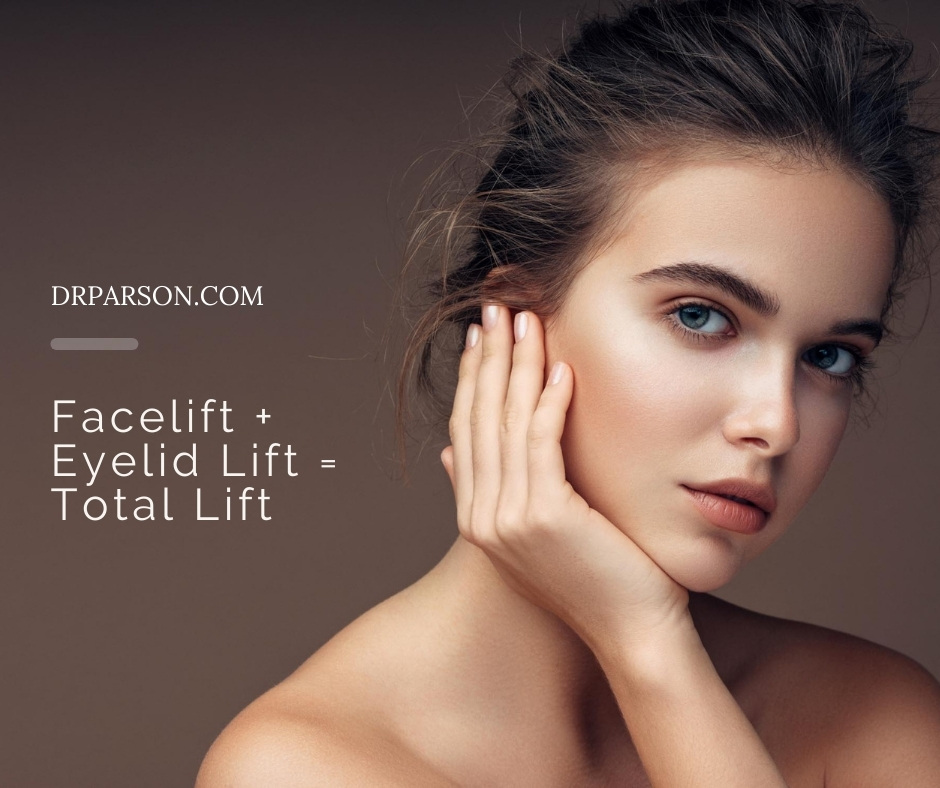
11 Nov Facelift + Eyelid Lift = Total Lift
Many people come to Dr. Shaun Parson Plastic Surgery & Skin Center rightfully thinking that a facelift lifts, well, the entire face. The name is a bit of a misnomer. A facelift actually only addresses sagging skin on the lower half of the face and the neck. That’s right—a neck lift is part of a facelift, but lifting the upper part of the face is not. However, you can add an eyelid lift to a facelift to achieve a more comprehensive youth-ifying effect. In fact, an upper eyelid lift, lower eyelid lift, or both are two of the most popular complements to a facelift or mini facelift. Let’s take a look at all of these procedures and see which one is right for you.
Where do you notice sagging and skin laxity? Most younger patients (those in their 30s and 20s) often see the first signs of aging around the eyes rather than the neck, cheeks, or jowls. This skin is thin and takes a lot of abuse. Even though a facelift is often the first facial plastic surgery people consider, in reality younger patients often benefit more from eyelid lifts and perhaps a mini lift.
Lifting the Eyes
Also known as blepharoplasty, eyelid lifts can dramatically turn back the clock. Upper and lower lifts are two very different procedures but can often be paired together. An upper lift addresses sagging, or ptosis, which is typically caused by skin laxity, a worn-out levator muscle, trauma, or a combination of all three. Our faces typically aren’t symmetrical to begin with and certainly don’t age symmetrically, so you might notice one eyelid is droopier than the other. An upper eyelid lift not only fixes sagging, but also creates symmetry.
Upper eyelid lifts require a very small incision in the crease of the eyelid so that excess skin can be removed. The procedure is surprisingly quick—under one hour in total. Sutures will remain in place for a few days after the surgery, which is the period when bruising and swelling is common. You’ll want to set aside at least one week to recover and let your eyes rest.
Lower eyelid lifts address sagging and bags in the undereye area. In many cases, there might also be fat pockets here that may need to be removed. If you only require removal of fat pads, incisions are made on the inside of the eyelid so they are never seen. If you will also benefit from removal of excess skin, this incision is made along the lower lashline. Sometimes lower lashes fall out during this surgery, but don’t worry. They will grow back. Again, swelling and bruising is common and stitches will be visible for a few days. For those who get both an upper and lower eyelid lift, plan for 7 – 10 days of recovery before you feel comfortable running errands and doing other non-strenuous public activities.
Facelift Facts
Today’s facelifts yield very dramatic and yet completely natural-looking results using the deep plane technique. With this approach, it is not just excess skin that is removed, but underlying tissue is also manipulated to turn back the clock. After all, it’s subdermal structures that age us along with lost skin elasticity—only addressing the skin is what led to the windswept look of the 1990s (and nobody wants to repeat that).
Incisions for both a full facelift and mini lift are surprisingly small and very well hidden. In most cases, incisions are hidden in the crevices of the ear. Sometimes small incisions will need to be made deep within the hairline. Either way, this results in a “ponytail facelift” aptly names because it leaves no visible incisions. Facelift incisions are no longer made behind the ear, which was a telltale sign that you “had something done” should you wear your hair back.
Choosing the Right Surgery for You
Will you benefit from a facelift, upper eyelid lift, lower eyelid lift, or all three? Would non-surgical procedures, such as a chemical peel, help you get the results that you want? Find out during a consultation with Dr. Parson. This no-pressure consult will help you determine your goals and what’s needed to get there. Schedule yours today by contacting Dr. Shaun Parson Plastic Surgery & Skin Center by calling the office or completing an online form.
